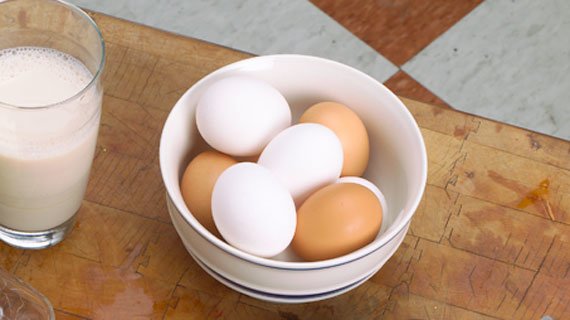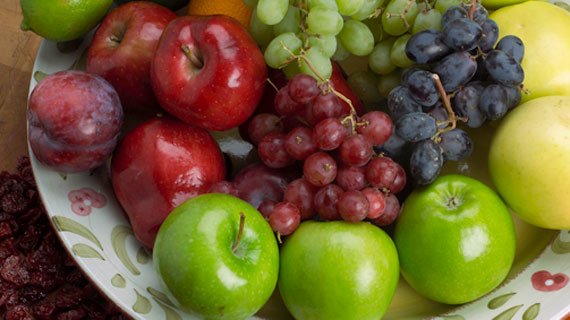How to Eat to Gain Muscle
Three Methods:
For many of us, gaining muscle may conjure up images of countless hours in the gym, but diet doesn't come to mind. Your body needs calories and nourishment to feed growing muscle mass and to adjust to varying amounts of activity. Before making sudden changes in your lifestyle, though, you may want to consult with a physician, personal trainer, and dietitian.
Method 1 of 3: Learning What to Eat
-
1Eat sufficient amounts of protein. The rule of thumb is that you need between 1 and 1.5 times your body weight in grams of protein. For example, if you weigh 150 pounds, you should eat between 150 and 225 grams of protein per day if you want to consistently gain muscle. Full time bodybuilders can eat two to three times their body weight in grams of protein, and sometimes more, but for most of us that would be overkill. If you're overweight, substitute your ideal body weight and calculate in grams. Proteins that are great for building muscle include:
- Red meat like beef, pork, lamb, venison, bison, etc.
- Fish like tuna, salmon, swordfish, bass, trout, mackerel, etc.
- Poultry breast, from chicken, turkey, duck, etc.
- Eggs, especially egg whites. The yolk is high in cholesterol, but one or two a day isn't unhealthy.[1]
- Dairy like milk, cheese, cottage cheese, yogurt, etc.
-
2Learn the difference between complete and incomplete proteins. In order tobuild muscle, you need to consume complete proteins found in eggs, meat, fish, cheese, milk and most other animal products. Rule of thumb: If it bleeds or breathes, it's a complete protein. There are lots of non-animal complete proteins available, as well, meaning that you can still build muscle as a vegetarian.[2] Complete vegetarian proteins include:
- Soy
- Quinoa
- Buckwheat
- Chia
- Hempseed
- Beans or legumes with rice
-
3Eat foods with a high Protein Digestibility Corrected Amino Acid Score (PDCAAS). This is a measure of how well different proteins are digested by the body, based on the solubility of the amino acids in the protein. Think of PDCAAS as grading the quality of protein, with 1 being the highest score and 0 the lowest.[3] Here's a breakdown common proteins by their rounded PDCAAS score:
- 1.00: egg white, whey, casein, soy protein
- 0.9: beef, soybeans
- 0.7: chickpeas, fruits, black beans, vegetables, other legumes
- 0.5: cereals and derivatives, peanuts
- 0.4: whole wheat
-
4Include carbohydrates in your diet. It is important to have carbohydrates so that your body can tap into glycogen (energy) stores within your muscles while you are working out. If you do not eat enough carbohydrates your body will not have energy reserves and will break down your muscles instead! To build muscle, your diet should consist of somewhere between 40% and 60% carbohydrates, or about 1500 calories per day.[4]
- Carbs get an unfairly bad reputation from dieting guides. Because complex carbs are broken down slowly and have a low-glycemic index (not as much sugar), they are acceptable to eat after a workout, and especially in the morning at breakfast. Try to select carbohydrates low on the Glycemic Index, which are healthier and release their energy more slowly [5]. Good examples are:
- Brown Basmati Rice
- Quinoa
- Rolled Oats
- Sweet Potato
- Wholemeal Rye Bread
- Wholemeal Spaghetti
-
5Eat healthy fats. Not all fats are created equal. In fact, there is evidence to suggest that eating healthy fats is actually good for you.[6] You should get about 20% to 35% of your calories from fats. Eat monounsaturated and polyunsaturated fats. These are the "good" fats. They include:
- Olive, peanut, sunflower, canola, and avocado oils.
- Fish.
- Nuts.
- Flaxseed and pumpkin seeds.
- Soy products such as tofu or soymilk.
-
6Stay away from saturated and trans fats. These are the "bad" fats. Make sure saturated fats make up no more than 10% of your caloric intake, and that trans fats make up no more than 1% of your caloric intake.[6] Bad fats include:
- Ice cream, candy bars, and packaged snack foods.
- High-fat cuts of meat.
- Lard, stick margarine, and vegetable shortening.
- Fried foods.
-
7Consume plenty of fiber. Remember it is important to include green vegetables in your diet such as spinach or broccoli to ensure that you receive an adequate amount of vitamins. As well, green leafy vegetables are high in fiber which is essential for removing waste from the body.
-
8Monitor your salt intake. It may be true that excessive consumption of salt can lead to hypertension but you lose tremendous amounts of sodium when you sweat. Also, sodium (a key electrolyte) aids in muscle contraction, which is one reason why it is found in many sports drinks.
Method 2 of 3: Learning How to Eat
-
1Eat when you're hungry. Sounds obvious right? Many muscle-builders get fooled into thinking muscle-building diets need to be more elaborate and complicated than they really do. Eating what you like, within the parameters mentioned in the previous section, is the key to gaining muscle mass consistently. If you're not eating what you like in a regular pattern, it'll be harder to consistently follow through with your diet. Here's asample diet to give you a better idea of what someone might eat throughout the day:
- Breakfast: egg-white omelet with turkey; whole grain toast; banana.
- Pre-lunch snack: mixed nuts; apple.
- Lunch: tuna salad with olive oil, onions and capers; sauteed kale.
- Pre-workout snack: cottage cheese with blueberries.
- Post-workout snack: protein shake; sauteed spinach.
- Dinner: orange-soy chicken breast with quinoa; stir-fry with carrots, onions, peas, and peppers.
-
2Create a calorie surplus. For many muscle-builders, it's important to combine an increase in protein with an increase in calories, so all your hard work at the gym won't work against you. You've got to build up enough fuel to burn as a way of building up your muscles, but not eat so many calories that they'll be transferred into fat. There's an ideal surplus of calories that you can find by calculating your maintenance calorie count, and your surplus.[7]
- Your maintenance calorie count is the number of calories you need to consume in an average day, with an average amount of energy output, to maintain your current body-weight. For most people with a healthy body-weight, this is around 2000 calories.
- Men should surplus about 250 calories a day (bringing the total to 2250), while women should surplus about 150 calories a day (bringing the total to 2125). Over the course of a given week of muscle-building exercise and proper nutrition, this calorie increase should translate into roughly .25-.5 pounds of muscle gained per week.
-
3Always eat breakfast. Breakfast is probably the most important meal of the day aside from your post-workout meal. Eating breakfast packed with protein, complex carbohydrates, and fiber will get your metabolism going. It will also keep your body from cannibalizing any muscle for energy. Remember the saying: "Eat breakfast like a king, lunch like a prince, and dinner like a pauper." Because you're not on a diet, however, you don't have to be a pauper at any time.
- Get protein into your breakfast. Omelets, shakes (or smoothies) and cottage cheese are great sources of protein.
- Eat complex carbohydrates for breakfast. While simple carbohydrates such as sugar and donuts are broken down easily and cause a spike in your sugar levels, complex carbs (oatmeal, bran, beans, whole grains) are broken down over longer periods of time and don't cause spikes in blood sugar.
-
4Eat less food more often. Eat at regular intervals to keep from getting so hungry that you splurge when you do eat. Your body will start to get hungry at the predetermined times you do eat because you've kept a consistent routine.
- Try eating breakfast, lunch, dinner, post workout, before bed (at least an hour before going to sleep) and slip in two snacks in between. Snacks can include everything from nuts and seeds to sides of veggies or fruit.
- If you're trying to gain muscle and lose weight, skip the before-bed meal. Eating right before you go to bed will cause the body to convert any not metabolized food into fat instead of energy or muscle. Your body's metabolism shuts down right before bedtime.
-
5Drink plenty of water all throughout the day. Dehydration can mean poor muscle recovery, so make sure you drink lots of water throughout the day. Sip on water throughout your workout. The recommended daily amount of water for men is about 3 liters (0.8 US gal), and 2.2 liters (0.6 US gal) for women.[8]
- Get a water filter to filter tap water. Buying a water filter is an economical way of converting your tap water into healthy, great-tasting water. Buy one and see your water consumption grow.
- Don't wait until you're thirsty to drink. Keep a steady supply of water going into your body, so you won't have to gulp or binge on water when you're dehydrated, which risks upsetting your stomach during workou



















.jpg)
